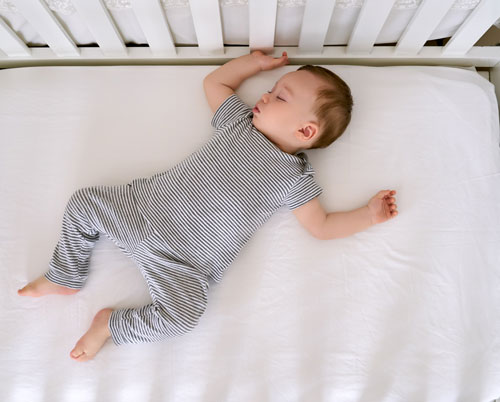It’s Infant Safe Sleep Week in Minnesota
The COVID-19 pandemic also has the potential to put infants at risk. Researchers have found that many infants who die unexpectedly had a recent upper-respiratory infection or cold, which might contribute to breathing problems. It is crucial for anyone who cares for babies — including parents, caregivers, childcare providers, health care workers and family members — to follow safe sleep practices every time an infant sleeps or naps. No infant should die due to an unsafe sleep situation.
Know the ABCs of safe sleep:
- Alone: Infants should always sleep or nap alone.
- Back: Always put babies on their backs to sleep or nap.
- Crib: Babies should always sleep or nap in their own safety-approved crib or play yard without blankets or pillows.
Babies can die of sleep-related, unintentional injuries while sleeping in unsafe conditions such as in an adult bed or on a sofa with parents or older children. Babies can become tangled in bedding, get stuck under pillows or trapped between a sleeping adult and the cushions of a sofa or recliner. Sometimes their sleeping parents roll over on them unintentionally, causing death from suffocation and chest compression.
The American Academy of Pediatrics recommends that all infants sleep on their backs in their own safety-approved crib and in a smoke-free environment to reduce the risk of SIDS and these tragic, preventable injury deaths.
To reduce the risk of SIDS, the American Academy of Pediatrics recommends that all infants:
- Sleep on their backs. Always place infants on their back to sleep.
- Use a firm sleep surface. Infants should sleep in their own safety-approved crib. The crib mattress can be covered with a fitted sheet. No soft objects or other bedding should be used.
- Breastfeeding is recommended. Breastfeeding is associated with a lower risk of SIDS. Unless not recommended by a health care provider, mothers should breastfeed exclusively or feed with expressed milk.
- Room share without bed-sharing. Infants should sleep in the parents’ room, close to the parents’ bed but on a separate surface (room sharing). The crib, portable crib, play yard or bassinet should be placed in the parents’ bedroom for at least 6 months but preferably a year.
- Consider offering a pacifier at nap time and bedtime once breastfeeding has been firmly established. Studies have reported a protective effect of pacifiers on the incidence of SIDS. The pacifier can be used when placing the infant for sleep. If it falls out once the infant is asleep, it does not need to be replaced. Do not use pacifiers that attach to clothing or toys when the infant is sleeping.
- Avoid overheating and head coverings. In general, dress infants appropriately for the environment. Use no greater than one layer more than an adult would wear to be comfortable in that environment.
- Avoid exposure to smoke during the pregnancy and after the baby is born.
- Avoid alcohol and illicit drug use during pregnancy and after birth.
- Avoid the use of any products or devices that are inconsistent with safe sleep recommendations. The Consumer Product Safety Commission (CPSC) offers safety standards for bedside sleepers. There are no safety standards for in-bed sleepers.
Safe Sleep Resources
- Infant Safe Sleep: Know the A-B-Cs (Somali and Spanish)
- What Does a Safe Sleep Environment Look Like? (Somali and Spanish)
- Safe Sleep Frequently Asked Questions (FAQ)
- See all Safe Sleep Recommendations from the American Academy of Pediatrics
Governor Tim Walz recently proclaimed Nov. 8-14, 2020, as Infant Safe Sleep Week. Read the proclamation.
